| Also known as: | Sagarmāthā (Nepal), Chomolungma (Tibet, China) |
| Elevation: | 8,848 m (29,029 ft) |
| Location: | Nepal, China (Tibet) |
| First ascent: | 29 May 1953 (Tenzing Norgay and Edmund Hillary) |
| Most popular route: | South Col (Nepal) |
| Range: | Himalayas |
| WGS84: | 27° 59′ 17″ N, 86° 55′ 31″ E |
All You Need to Know About Mount Everest
Love mountains? Check this out: TOP 10 most amazing mountains in the world- Infographics
- Shocking Truth
- How Much is it to Climb?
- Interesting Facts
- Where is Mount Everest Located?
- How was it Named?
- How Tall is Mount Everest?
- Mount Everest Base Camps
- How Long Does it Take to Climb?
- First Person to Climb
- Videos
- Photos
- Share
- TOP 10 most beautiful mountains in the world
The Highest Mountain in the World
Everest (or Chomolungma, as it's called in Nepal), at 8,848.43 meters high, is the dream for every climber, but without a doubt it is the most dangerous challenge and the most deadly mountain on Earth. Yes, it is the highest place on our planet and the most famous summit every kid in every country knows about. But the story of its discovery and of brave people who tried to summit it is often unknown for public. Having the form similar to a pyramid due to glacier dissection, Everest rises just right on the border between two Asian countries: China and Nepal.
Infographics
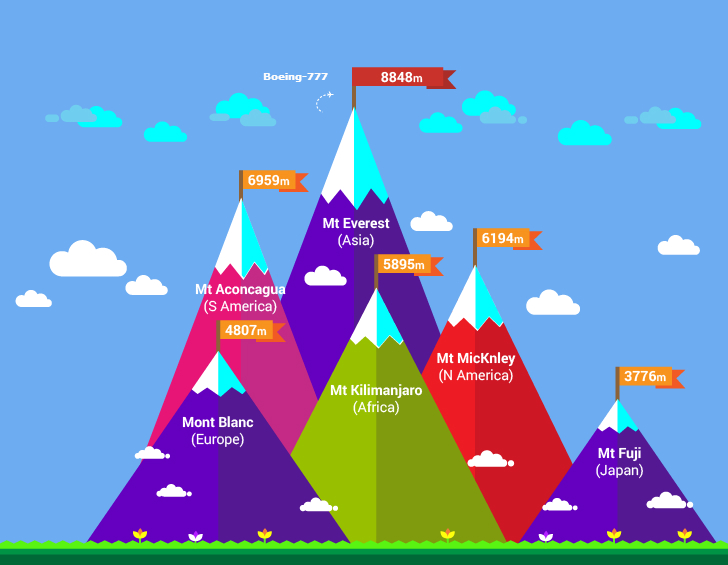
Shocking Truth
This peak is truly considered one of the most magnificent yet tragic and dangerous places in the world. Its rocky silhouette has attracted numerous brave and courageous people to reach the peak. Regretfully, many of them stayed in its snow and rocky cliffs forever. Over 235 climbers and local people have died while attempting to come up the highest peak of the globe, though the exact number is still unknown, as not everyone registers before their trip. It's about the pressure and rarefied air, which is impossible to breathe for a long time. Though, despite the danger, freezing cold air and lack of oxygen in air they breathe, numerous people risk their lives for being on the top of the world for a small amount of time. What is so special about it?

How Much is it to Climb Everest?
Nowadays, this is a very popular question, as we all know, that high-altitude expeditions are a pay-to-play game, and you need to not only be physically ready and skilled in mountaineering, but you also need to be ready to pay for it. The minimum price is about $30,000 if you go on your own. Travel companies offer guided expeditions, and the price for their service is around $60,000. The VIP expedition service, which includes constant Internet and phone access, is as high as $90,000. Overall, it depends on the guide and the number and quality of services included in the package. However, when choosing your guide and company to work with, it is important to consider not only the price and name of the provider. It is always better to research and find out if the flight is included. Also, it is recommended that you see if the Sherpa service is included as well. Because sometimes you need to pay the Sherpas when you are in the base camp to avoid unexpected surprises, it is always better to pay attention to details.
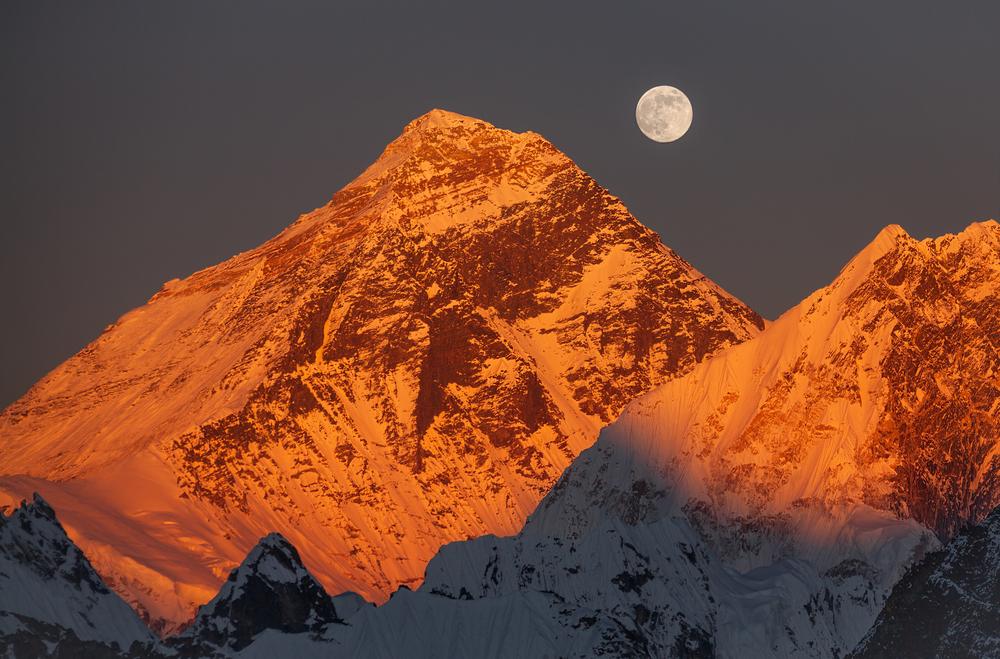
Why so Expensive?
The Nepalese government charges a mandatory fee on all foreigners who want to climb Everest. Depending on the size of the group and period of time in can vary from $11,000 to $25,000.
Many readers are now outraged: "Such a rip off!" But on the other hand, think for yourself. Even at these prices on the slopes are more than 200 dead and there are dozens of tons of garbage. Imagine what would happen if this fee was not in place. The number of climbers would increase dramatically, and Everest would be something in between a dump and a morgue.
Another important thing is a set of necessary equipment, which also costs a lot of money. Expenses for the services of guides and climbers and Sherpas often depend on the size of the group, so they vary from year to year.
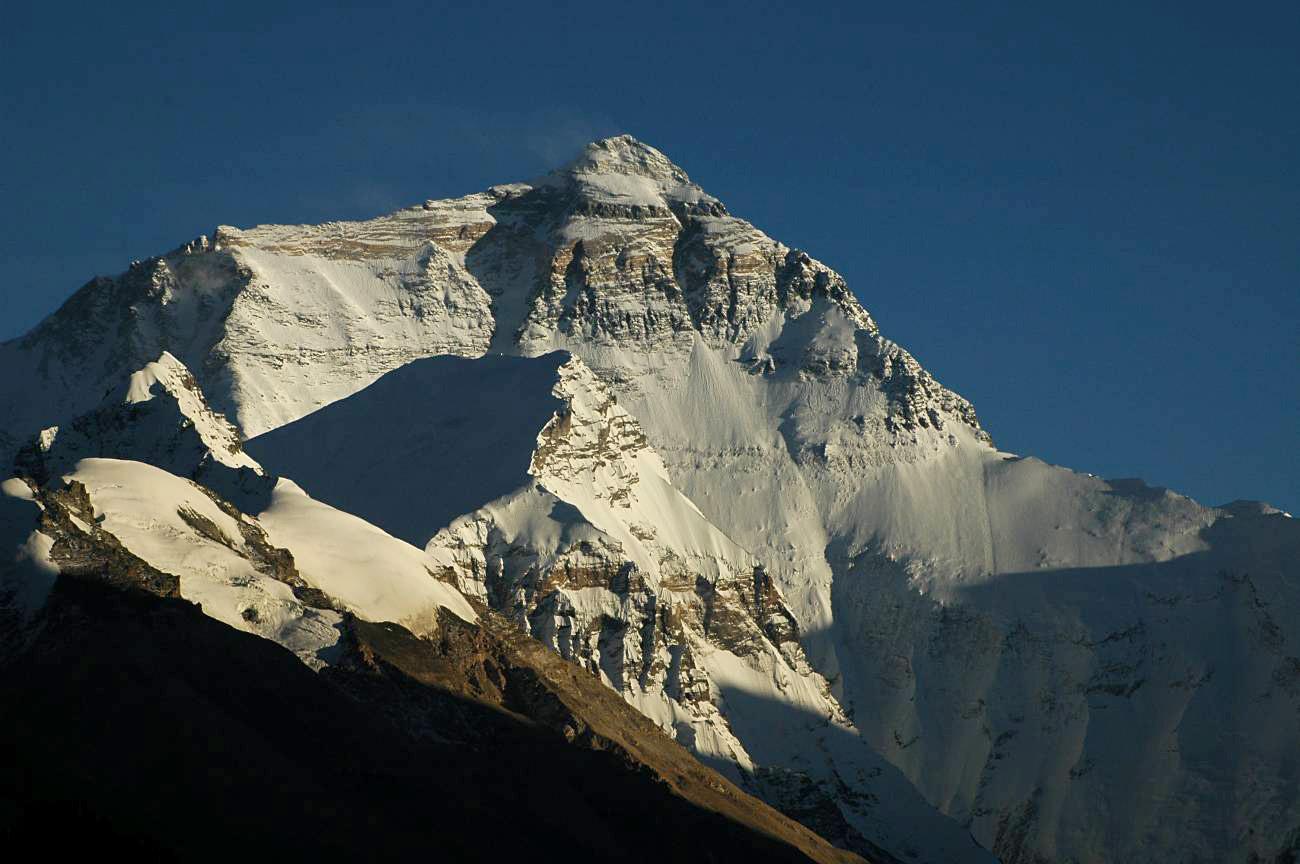
Mount Everest Facts
- Everest, a part of Mahalangur chain, is 29,035 feet (equal to 8,848 meters) high.
- An inactive volcano from Hawaii, Mauna Kea, holds first place in a rating of world's highest mountains, not counting sea level.
- It is over 60 million years old, and it was formed due to the pushing movement of one tectonic plate (the Indian) right into the Asian plate. Due to the tectonic activity in the region, Everest becomes about a quarter of an inch (0.25") higher every year.
- The summit is located right on the border line of Nepal (in the south) and China (also known as Tibet) on the north.
- Chomolungma (derived from the Tibetan) means holy mother of the universe.
- To keep warm, the climbers are recommended to use oxygen on top. As for the food, before the summit, they eat a lot of rice and noodles, as they consume a lot of energy when they get to the summit. Still, on average, the mountaineers burn more than 10,000 calories on a daily basis, and this number is doubled during the summit climb. Overall, climbers normally lose from 10 up to 20 pounds of weight throughout their expedition.
- Throughout history, it was reported that 282 people (including 169 Western mountaineers and 113 Sherpas) died on Everest for the period of 1924 up to August 2015. Talking about the deaths and their reasons, 102 mountaineers died while attempting to summit without usage of the supplemental oxygen. The majority of dead bodies have all stayed in the snows on the mountain, though China reported that they removed many bodies from there. The top reason of death is because of falls, then avalanches and exposure, and due to altitude sickness.
- The youngest person who ever summited was an American guy named Jordan Romero, at the age of 13, on May 23rd, 2010 (he managed to do that from the north side).
- 14 mountaineers managed to traverse from one side to another.
- The wind can blow there at the speed being over 200 mph.
- Roughly, it takes around 40 days to summit Mt. Everest, because some time is still required for the body to get used to the high altitude.
- The first climbers who managed to summit Everest without usage of the bottled oxygen were the team of Reinhold Messner and Peter Habler (Italian) back in 1978. Later on, following their example, 193 mountaineers also managed to summit without usage of the supplemental bottled oxygen (it is around 2.7% of all the summits). Overall, there is around 66% less oxygen in every breath on the top of Everest than you would normally breathe at sea level.
- There have been over 7,000 summits of Everest as of now, conducted by means of all reported routes by over 4,000 various people.
- The oldest person who managed to conquer the mount was Miura Yiuchiro (from Japan), being 80 years old, on May 23rd, 2013.
- There are 18 various official climbing routes to the summit of Everest.
- The first woman who stepped on the summit of Everest was a Japanese mountaineer Junko Tabei (back in 1975).
- To prevent falling, mountaineers use nylon ropes (10-mm in diameter). To ensure a successful way to the top, the mountaineers wear spikes on their sports boots, which are called crampons. Besides that, they utilize ice axes, which can stop them if they are falling down on rocky and icy surface. As for the clothes, they wear thick suits which are filled with goose feathers.
- Sherpa is the generic name of people who live in the west of Nepal. Originally, they migrated from the Tibet side over several centuries ago. They help the mountaineers to carry food, tents and supplies in the intermediate camps, located over the base camps.
- Mountaineers start using their bottled oxygen at the altitude of 7,925 m (26,000 feet); however, it makes just a 915 m (3,000 feet) difference in the way they feel. Overall, at the altitude of 8,230 m (27,000 feet), one will feel like they are at the 7,315 m (24,000 feet) above sea level, which is not that significant of a difference.
- The temperature can become as low as -62C (80F below zero).

History
Everest was created by the Earth 60 million years ago. The mountain has a pretty long history of “first climbers,” starting from the first unsuccessful effort in 1921 by the British expedition of George Mallory and Guy Bullock. The first humans got on a mountain peak in 1953 and they were the brave alpinists Edmund Hillary and Tenzing Norgay. On May 23, 2013 Yuichiro Miura, at the age of 80, became the oldest person to climb Mount Everest. But the highest peak in the world is not just a sightseeing point or challenge for climbers; it's also a home for highlanders, the people of Sherpa, who have been living there for more than 500 years. This little nation of people are the best guides and porters for tourists and professionals who decided to play with death and to climb the highest mountain and the toughest on our planet.
Where is Mount Everest Located?
Mount Everest is not just the highest mountain, it beats another record - it's the highest border between two countries as well. The mountain stretches between the territories of China and Nepal, but its peak is located in China - or, rather, in the Tibetan Autonomous Region. Everest is included in the mountain system of the Himalayas and is just one of nine peaks of Himalaya mountain massif. Interestingly, the Himalayan Mountains consist of 39 of the highest peaks in the world, so Everest has many of its youngest brothers. Together they form a fence between the Tibetan plateau and the Indian subcontinent.
The whole mountain system is located in South Asia, and it passes through Pakistan, Bhutan, Tibet, India and Nepal. That is the reason for the fact that Mount Everest has several names. In Tibet it is called “Chomolungma” or “Qomolangma.” In Chinese it's "Shengmu Feng". Locals in Darjeeling call it “Deodungha,” which is translated as "Holy Mountain.” For many years the location of the world's highest mountain was supposed to be in the Andes and only in 1852 a mathematician from India and a Bengalese surveyor discovered the real highest peak in the world.

How was it Named?
The highest mountain in the world was originally discovered by George Everest, who used to be the Surveyor India General, in 1841. Since then, the official name, which was given of the highest peak on the Earth, is taken after his own. This name was provided only in 1865, as there were miscellaneous local names of this impressive peak, but the highest mountain, in fact, needed to have one name, recognized internationally. Andrew Waugh was the one who insisted on giving the name of his predecessor on the high post in India to the mountain that he reported to be the highest.

What Country is Mount Everest In?
Throughout history Mount Everest was a part of China or Nepal, just as it happened with the Tibetan Autonomous Region. But even nowadays the authorities of Tibet are trying to return its independence from People's Republic of China, after the annexation in May of 1959. The relations between Nepal and China are absolutely friendly, and it's almost a symbolic fact that the border between the two countries meets at the world's highest mountain. So theoretically, the peak that is closest to the cosmos doesn't belong to one state; instead, it's common ownership of Nepal and China. Every tourist who decided at least to watch Everest on his own can choose from what side he would like to do it, but it's a matter of fact that Everest on the side of Nepal is more beautiful, as well as easier in terms of climbing.

How Tall is Mount Everest?
Imagine that you live in a world where there is no Mount Everest, it's still undiscovered and in school your teacher tells you that the highest mountain is something called Kangchenjunga, or Dhaulagiri, for example. But even in XX century society was sure that the highest point on our planet was everything but Everest. Only in 1852 was Mount Everest confirmed to be the highest mountain in the world. The height of the mountain is 8,848 meters above sea level, and it annually increases by about 4 millimeters, due to plate motion. Furthermore, earthquakes in Nepal can move Mount Everest and even change its height. And modern scientists continue to prove that neither China's nor Nepal's measurements of the mountain are true. Chomolungma continues to grow. Continental plates are not standing still, and instead they constantly push Everest higher.
It is curious that the exact height of Everest is still a subject of dispute. Back in 1856, when the British explorers first managed to manage the height of the peak with the help of theodolite, it was recorded to be 8,840 m (or 22,002 feet). Nowadays the official height of Everest is declared 8,848 m (which is equal to 29,029 feet). To imagine how high Everest is, it is enough to say that its summit would be located just below the regular cruising level of a jet. That is why it is no wonder that there is almost no wildlife at this height, due to low pressure and rarified low-oxygen air, although Everest is home to one rare kind of spider, which hides in the crevices. This black jumping spider feeds on frozen insects that are getting to the top with the winds and snow masses.
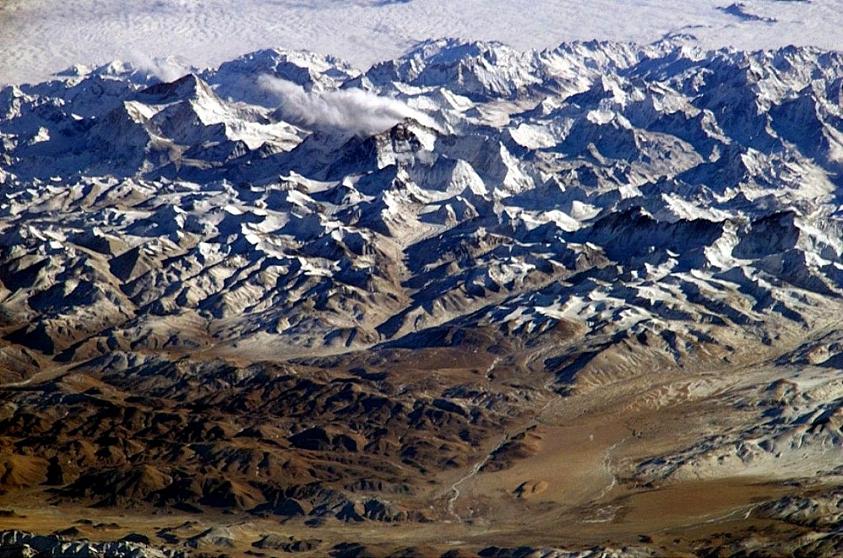
"Neighborhood"
Talking about the Everest massif, it consists of several separate peaks, such as Changtse, which is 7,580 m (24,870 feet) high, Nuptse, which its 7,855 m (58,772 feet) and Lhotse being 8,516 m or 27,940 feet high. It was extremely challenging to measure the exact height of the mountain, since there were devices, called theodolites, which weight over 500 kg (1,100 pounds), which required 10 to 15 men to carry it. They have conducted multiple attempts to measure the exact height of Everest, and thus finally came up with the adequate measurement of the Everest height only in 1949.
The closest place people live in is Rongbuk Monastery, a Buddhist temple which was founded back in 1902 and was recently reconstructed after total demolishment in the 1970s during civil fights in this area. Nowadays, this is truly the last resort for those mountaineers who are coming up to one of base camps. In the Rongbuk Monastery one can stay in a small hotel and a tiny restaurant.

About Height
During almost 300 years, the highest known point on Earth was Chimborazo, a volcano in the Andes. Its height is “only” 6,267 meters. In XIX century this presumption was busted, and a new champion has been found - Mount Nanda Devi in India with a height of 7,816 meters. That could sound like a joke, but today Nanda Devi is ranked only 23rd on the list of world's highest mountains. But there is a reason these “kids” were supposed to be the highest - all the region of Nepal with its “roof of the world” was closed to all the outside world for a long time.
Interesting Things to Know
Mount Everest is officially considered to be one of the most polluted mountains in the world because of the lack of infrastructure and a strong influx of tourist garbage, ranging from simple packages of food and ending with oxygen cylinders and old equipment that are all stored and accumulated for decades on this sacred mountain for the local community.
It is also quite interesting that today scientists are constantly finding the remains of marine life, which remained in the stone breed ever since for 450 million years, in the times when the surface of Mount Everest was nothing other than the seabed, and that's despite the fact that the Himalayas were formed just 60 million years ago. And if we talk about the facts of humans then, for example, one can ask a question, who visited the peak of Everest more than anyone? These are two Sherpas, Apa Sherpa and Tashi Purba, and they enjoyed the highest landscape 21 times.
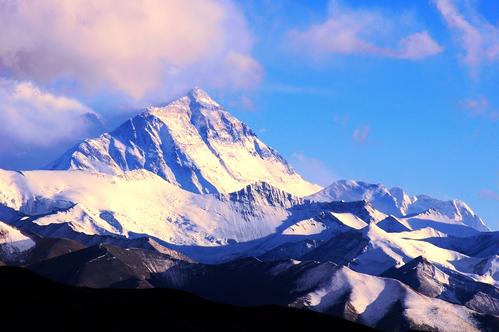
Deaths
Sadly, Mount Everest is proven to be a very challenging place to reach, one of the most dangerous places in the world, as its low temperatures, low level of oxygen within the air and dangerous avalanches have taken numerous lives of the local citizens and the courageous mountaineers. The greatest tragedy within Everest history happened in 2014, when a huge avalanche killed 16 local Nepalese guides. It happened near one base camp. Earlier, the second most tragic accident took place in 1996, when around 15 people died in their attempt to just return from the peak of the world.
These people died due to different reasons, some due to improper equipment, some because of lack of oxygen in gas cylinders and due to the unexpected snowstorm, which made it impossible for the team to return to their starting point in time. This was the second most numerous accident of taking that many human lives in one year in this location. The third most tragic situation occurred in 2012, when 11 people stayed forever on their way to Everest. Overall, there are around 200 dead bodies on the mountain, while the exact number still remains unknown. They are buried in the snows and rocks of Everest. Avalanches and falls are the most regular reasons of fatal accidents on Everest.

Mount Everest Base Camps
For anyone who dared to climb Everest there are, as already mentioned, two alternatives: either you go to China, or to conquer the giant hill from the Nepalese side of the mountain. In order to get used to the specific weather and climatic conditions at such a height on both climbs there are two base camps, where everyone, every single tourist who plans to further rise, is obliged to carry out really a lot of time, so the body can get used to such conditions and prevent altitude sickness. In both camps there are doctors who can give advice to the climbers before ascent. Staying for some time, as required, in a base camp helps the mountaineers reduce the possible risk of health problems related to the pressure change and altitude sickness.
South Camp is located in Nepal, while the North one is in the territory of Tibet (China). Despite the fact that the northern camp in the summer days can be reached by car, a more and more popular camp is at South side. And, of course, all the inhabitants of the surrounding villages, who were previously engaged in farming and cattle breeding, are now fully focused on providing visitors with anything they need - they help to raise luggage up to the mountain, offer food and water, as well as a variety of products. In addition to the above two camps on the way to Everest, there are several others, before and after, but they are designed for those who really decide to get to the highest point of the Himalayas.
The supplies to the South base camps are delivered by Sherpas and porters, since there are no transportation means to deliver food and medicine, as well as other necessary things to this area. The most popular shipping method here is with yaks, local animals capable of carrying heavy luggage.

Climbing
If you think that everyone can climb Everest, even with a very strong desire, you are greatly mistaken. Firstly, it is very expensive, about $60,000. The ascent to the highest mountain in the world is not such great fun, is not a simple and cozy tourism, it is a challenge and puts the climber in mortal danger. Every year several tourists die in an attempt to conquer this rocky giant, someone breaks into the abyss or gap between the glaciers, someone does not stand up to extreme temperatures, and someone gets altitude sickness.
Naturally, in such a challenge, professionals will need a huge amount of special equipment such as shoes, clothes, tools and electronic gadgets, as well as a large team of experts accompanying him, and years of experience climbing the other peaks. But if you talk about the process, it is, of course, fascinating. No matter which route you go, it is advisable to travel with the companionship of a Sherpa. Today the Himalayan region is home for approximately 3,000 Sherpas, and all of them are first class guides, porters and conquerors of vertices. In short, the Highlanders. If you've seen the famous photograph of the first people on Mount Everest, you will understand how inexpressible such feelings can be. In the words of Tenzing Norgay, “I wanted to jump, to dance, those were the best feelings in my life, I was standing in front of the whole world.”
The most popular season for Everest climbing is spring. Autumn expeditions are less popular. Today, the most popular way to climb Everest is by means of guided climbing. It ensures that the professional guide, who is guaranteed to know the most reliable path to the summit, can always instruct on what to do if something extraordinary happens and will always be with the group. Besides, the guide will explain everything that one needs to know before the start of climbing, will help choose the needed equipment and will verify the physical condition, as well as health state, of the participants in advance.

The Plan
The very first step to climbing Everest is excellent physical condition and proper experience in mountain climbing, as this process is risky and dangerous and requires certain skills. The expedition starts at one of the base camps (South or North), depending on the climbing plan. Next, the participants spend some time (around a week) in a base camp, located at the altitude of around 5,000 m (16,000 feet). Here they can talk to the experienced guides, verify their physical state and take some rest prior to climbing Everest. Then, the mountaineers are provided with food, necessary supplies and oxygen and review the equipment they take. At extra expense, groups may be willing to order Sherpa assistance, which means that all the extra oxygen will be carried for them.
How Long Does it Normally Take to Climb Mount Everest?
Surely, to climb to the roof of the world doesn't mean walking a few days through the picturesque, snow-covered slopes. For the untrained climbers and for people with a minimum risk of any disease, the period of acclimatization at the average height (in the base camp, altitude of 5,100 meters) may in some cases be up to 30-40 days, and during the whole month you will be surrounded by the Sherpa and your colleagues, until your body gets used to the air pressure and the lack of oxygen. Only then can you continue to climb. On average, when it comes to tourist destinations, the entire climb, since your arrival in Kathmandu and ending your step on the highest point in the world, takes about 60 days. When everything is set up, it takes around 7 days to come from the base camp up to the summit. After that one might need around 5 days to come down into their base camp.

First Person to Climb Mount Everest
Even though the first man on the top of the world was Edmund Hillary, long before him there were many attempts to conquer Everest. Back in the 1920s the special expedition of the newly established Committee of Mount Everest had been discovering the most convenient routes, and members of these expeditions were among the first to set foot on the "sacred mountain," as Everest is for locals. And yet, two completely different people, Sir Edmund Hillary, a New Zealander, and Nepali mountaineer Tenzing Norgay, jointly by climbing on the southern route, finally got there, in a place where never before in history had a man set foot.
In 1953, when this outstanding event for all of the humanity happened, China closed Everest for any visits, and the world community has only been allowed one expedition per year. Together, constantly tormented by the strong winds, because of which they often had to stay in one place for a few days, Norgay and Hillary climbed to the roof of the world. Edmund Hillary dedicated his achievement to the coronation of Queen Elizabeth II, and it was the best gift for this landmark event in the UK. Although Hillary and Norgay spent just 15 minutes at the top of the mountain, these 15 minutes today are comparable only to that of the first step on the moon.
The youngest person who ever reached the summit was an eighth-grade student from California, and he was only 13 when he summited Everest. The Nepalese 15-year-old girl Ming Kipa Shira was the second youngest person to conquer Everest, back in 2003. The oldest man who summated Everest was 80-year-old Miura Yiuchiro from Japan. The oldest woman who stepped on the Everest peak was Tamae Watanabe from Japan, as she summited at the age of 73.
If you enjoyed this article you will definitely LOVE this: Amazing photos, incredible stories, fabulous placesVideos
Photos



Photos: prudek, bbbbar, blasbike, kiwisoul, muha04, OSHI, v.apl / depositphotos.com
Share!
 Author: Michael Himmel
Author: Michael Himmel
Mountaineer, adventurer, traveler. Worked as a professional photographer and
journalist. Visited more than 50 different countries. Climbed Mount Everest and
other mountains. Likes exploring wild places and sharing the experiences with
other people.
Quick Navigation:






